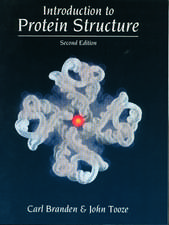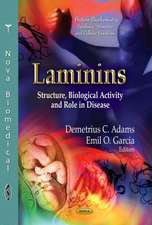Lipids in Protein Misfolding: Advances in Experimental Medicine and Biology, cartea 855
Editat de Olga Gurskyen Limba Engleză Hardback – 21 iul 2015
Din seria Advances in Experimental Medicine and Biology
- 9%
 Preț: 719.56 lei
Preț: 719.56 lei - 5%
 Preț: 717.00 lei
Preț: 717.00 lei - 5%
 Preț: 717.00 lei
Preț: 717.00 lei - 15%
 Preț: 640.24 lei
Preț: 640.24 lei - 5%
 Preț: 715.71 lei
Preț: 715.71 lei - 5%
 Preț: 716.28 lei
Preț: 716.28 lei - 20%
 Preț: 691.93 lei
Preț: 691.93 lei - 5%
 Preț: 1031.00 lei
Preț: 1031.00 lei - 5%
 Preț: 820.42 lei
Preț: 820.42 lei - 5%
 Preț: 716.28 lei
Preț: 716.28 lei - 15%
 Preț: 641.38 lei
Preț: 641.38 lei - 5%
 Preț: 717.20 lei
Preț: 717.20 lei - 5%
 Preț: 715.35 lei
Preț: 715.35 lei - 5%
 Preț: 1113.83 lei
Preț: 1113.83 lei - 20%
 Preț: 1161.71 lei
Preț: 1161.71 lei - 5%
 Preț: 1170.51 lei
Preț: 1170.51 lei - 18%
 Preț: 1119.87 lei
Preț: 1119.87 lei - 5%
 Preț: 1288.48 lei
Preț: 1288.48 lei - 5%
 Preț: 1164.67 lei
Preț: 1164.67 lei - 5%
 Preț: 1101.73 lei
Preț: 1101.73 lei - 18%
 Preț: 1123.67 lei
Preț: 1123.67 lei - 5%
 Preț: 1435.64 lei
Preț: 1435.64 lei - 20%
 Preț: 1044.10 lei
Preț: 1044.10 lei - 18%
 Preț: 946.39 lei
Preț: 946.39 lei - 5%
 Preț: 292.57 lei
Preț: 292.57 lei - 18%
 Preț: 957.62 lei
Preț: 957.62 lei - 18%
 Preț: 1235.76 lei
Preț: 1235.76 lei - 5%
 Preț: 1231.55 lei
Preț: 1231.55 lei - 5%
 Preț: 1292.30 lei
Preț: 1292.30 lei - 5%
 Preț: 1102.10 lei
Preț: 1102.10 lei - 18%
 Preț: 1132.81 lei
Preț: 1132.81 lei - 5%
 Preț: 1165.19 lei
Preț: 1165.19 lei - 5%
 Preț: 1418.48 lei
Preț: 1418.48 lei - 5%
 Preț: 1305.63 lei
Preț: 1305.63 lei - 18%
 Preț: 1417.72 lei
Preț: 1417.72 lei - 18%
 Preț: 1412.99 lei
Preț: 1412.99 lei - 24%
 Preț: 806.15 lei
Preț: 806.15 lei - 18%
 Preț: 1243.29 lei
Preț: 1243.29 lei - 5%
 Preț: 1429.44 lei
Preț: 1429.44 lei - 5%
 Preț: 1618.70 lei
Preț: 1618.70 lei - 5%
 Preț: 1305.12 lei
Preț: 1305.12 lei - 18%
 Preț: 1124.92 lei
Preț: 1124.92 lei - 5%
 Preț: 1097.54 lei
Preț: 1097.54 lei - 15%
 Preț: 649.87 lei
Preț: 649.87 lei - 5%
 Preț: 1097.54 lei
Preț: 1097.54 lei - 18%
 Preț: 945.79 lei
Preț: 945.79 lei - 5%
 Preț: 1123.13 lei
Preț: 1123.13 lei - 20%
 Preț: 816.43 lei
Preț: 816.43 lei
Preț: 954.31 lei
Preț vechi: 1163.80 lei
-18% Nou
Puncte Express: 1431
Preț estimativ în valută:
182.60€ • 191.17$ • 151.10£
182.60€ • 191.17$ • 151.10£
Carte tipărită la comandă
Livrare economică 07-21 aprilie
Preluare comenzi: 021 569.72.76
Specificații
ISBN-13: 9783319173436
ISBN-10: 331917343X
Pagini: 330
Ilustrații: XIII, 260 p. 83 illus., 57 illus. in color.
Dimensiuni: 178 x 254 x 20 mm
Greutate: 0.7 kg
Ediția:1st ed. 2015
Editura: Springer International Publishing
Colecția Springer
Seria Advances in Experimental Medicine and Biology
Locul publicării:Cham, Switzerland
ISBN-10: 331917343X
Pagini: 330
Ilustrații: XIII, 260 p. 83 illus., 57 illus. in color.
Dimensiuni: 178 x 254 x 20 mm
Greutate: 0.7 kg
Ediția:1st ed. 2015
Editura: Springer International Publishing
Colecția Springer
Seria Advances in Experimental Medicine and Biology
Locul publicării:Cham, Switzerland
Public țintă
ResearchCuprins
Role of Lipids in Folding, Misfolding and Function of Integral Membrane Proteins.- Protein Misfolding in Lipid-Mimetic Environments.- Lipids in Amyloid-β Processing, Aggregation, and Toxicity.- Role of Cholesterol and Phospholipids in Amylin Misfolding, Aggregation and Etiology of Islet Amyloidosis.- Stability, Oligomerization, and Amyloidogenicity of Apo Serum Amyloid A.- Interactions of Lipid Membranes with Fibrillar Protein Aggregates.- The Role of Lipid in Misfolding and Amyloid Fibril Formation by Apolipoprotein C-II.- Amyloid-Forming Properties of Human Apolipoproteins: Sequence Analyses and Structural Insights.- Computational Approaches to Identification of Aggregation Sites and the Mechanism of Amyloid Growth.- Role of Syndecans in Lipid Metabolism and Human Diseases.
Textul de pe ultima copertă
This book addresses molecular mechanisms of protein misfolding and the role of lipids and related molecules in these complex processes. The focus is on the biophysical and structural studies of proteins that are involved in major human disorders such as Alzheimer’s disease, systemic amyloidoses, diabetes II, inflammation and atherosclerosis. Misfolding often results from protein mutations or modifications. Misfolding of membrane proteins can cause topological changes that target the proteins for degradation. Misfolding of soluble globular proteins and peptides converts them into β-sheet-rich aggregates and amyloid fibrils. This process can disrupt the structural integrity of the lipid membranes and thereby contribute to amyloid toxicity. In turn, lipids and lipid-associated molecules such as apolipoproteins and heparan sulfate proteoglycans, which are ubiquitous constituents of amyloid plaques, can influence protein misfolding via diverse mechanisms that are addressed in this book.
The book features chapters describing the role of lipids in the misfolding of a wide range of proteins, including small peptides, globular proteins, lipid surface-binding proteins, and integral membrane proteins. The role of individual lipid molecules, lipid surfaces, and the membrane field is addressed, including specific and non-specific interactions with protein oligomers and mature fibrils. Distinct effects of various lipids on the nucleation and growth of amyloid fibrils are discussed. Modern computational approaches to the analysis of amyloid formation are addressed. The book should be useful to experts in the field but is also accessible to novices.
The book features chapters describing the role of lipids in the misfolding of a wide range of proteins, including small peptides, globular proteins, lipid surface-binding proteins, and integral membrane proteins. The role of individual lipid molecules, lipid surfaces, and the membrane field is addressed, including specific and non-specific interactions with protein oligomers and mature fibrils. Distinct effects of various lipids on the nucleation and growth of amyloid fibrils are discussed. Modern computational approaches to the analysis of amyloid formation are addressed. The book should be useful to experts in the field but is also accessible to novices.
Caracteristici
Explains how protein misfolding is an important biological phenomenon underlying over 20 major human diseases Shows that Lipids importantly influence protein misfolding and amyloid diseases Provides an up-to-date analysis of the roles of lipids in protein misfolding Discusses a wide array of proteins, lipids and their modes of interaction Focusses on the biophysical and structural properties of the interacting partners Complements the small collection of books on this topic in this rapidly developing field













